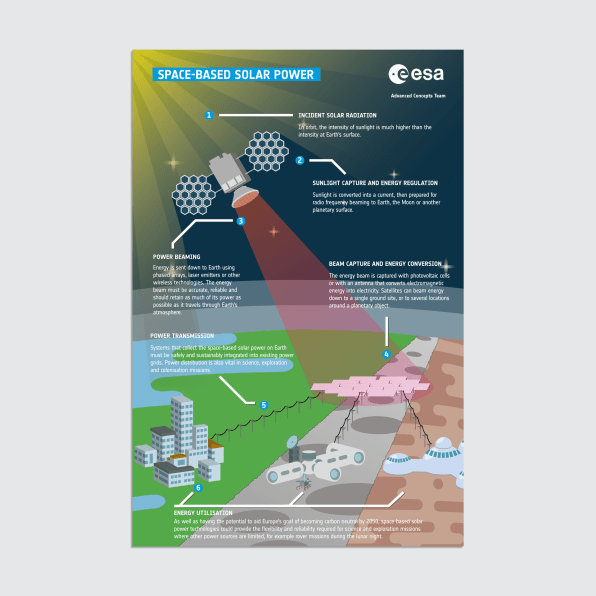What if we put the solar panels in space so they could be closer to the sun?
Solar farms here on earth are generating an increasing amount of power for the grid, but they suffer from some obvious problems. They can’t generate power when it’s cloudy or at night. And they are very far away from what’s actually generating the power: the sun. But transport that structure all the way up through the Earth’s atmosphere and into outer space, and it could beam a constant supply of power down to Earth. That’s the big idea being presented to the European Space Agency (ESA) in November 2022, as part of the sci-fi sounding Solaris project.

The outer-space solar farm would be “assembled in orbit into a single mega structure” says Sanjay Vijendran, a scientist at the ESA who has taken a break from his work on Mars exploration strategy to focus on the solar project. If the satellites are placed high enough up in orbit—about 22,000 miles away—they can avoid the Earth’s shadow entirely, instead maintaining a constant supply of powerful sunlight. “That’s just impossible to get on the ground because of the day/night cycle, because of the seasons and weather and clouds and things like that.” says Vijendran, who we spoke with on this week’s episode of World Changing Ideas.
Sunlight picked up in outer space would be converted into microwaves and then beamed down through the Earth’s atmosphere, where they would be picked up by an antenna or electrical receiver that would stretch across an area more than a mile long. The antenna would then convert the microwaves back into electricity and channel them straight into the grid.
There are, of course, a number of public safety concerns involved with this, which require further research, Vijendran says, “including the safety of the microwaves with living things, but also compatibility with satellites or aircraft that might pass through the beam.” Right now, scientists anticipate that levels of radiation are expected to be the equivalent of standing next to your running microwave oven, but that would still need regulatory approval before any trials begin.
Of course, there are large-scale challenges involved, too. Will the project be able to create a long-lasting structure that can withstand the impact of space debris or meteorites and be easily repaired all the way up in space?
Robotic repair systems for outer space maintenance is a fast-growing area, which could be the key to making something like the Solaris project more than just science fiction. If Solaris gets the green light for investment and full development in 2025, the ESA would plan to have a commercial outer space solar park constructed by 2040.
Want to hear about more futuristic inventions that people around the world are creating to solve the climate crisis? You can listen and subscribe to our World Changing Ideas podcast on Apple Podcasts, Google Podcasts, Stitcher, Spotify, or wherever you get your podcasts.
<iframe frameborder=“0” height=“200" scrolling=“no” src=“https://playlist.megaphone.fm?e=MANV2897050844” width=“100%“></iframe>(10)


